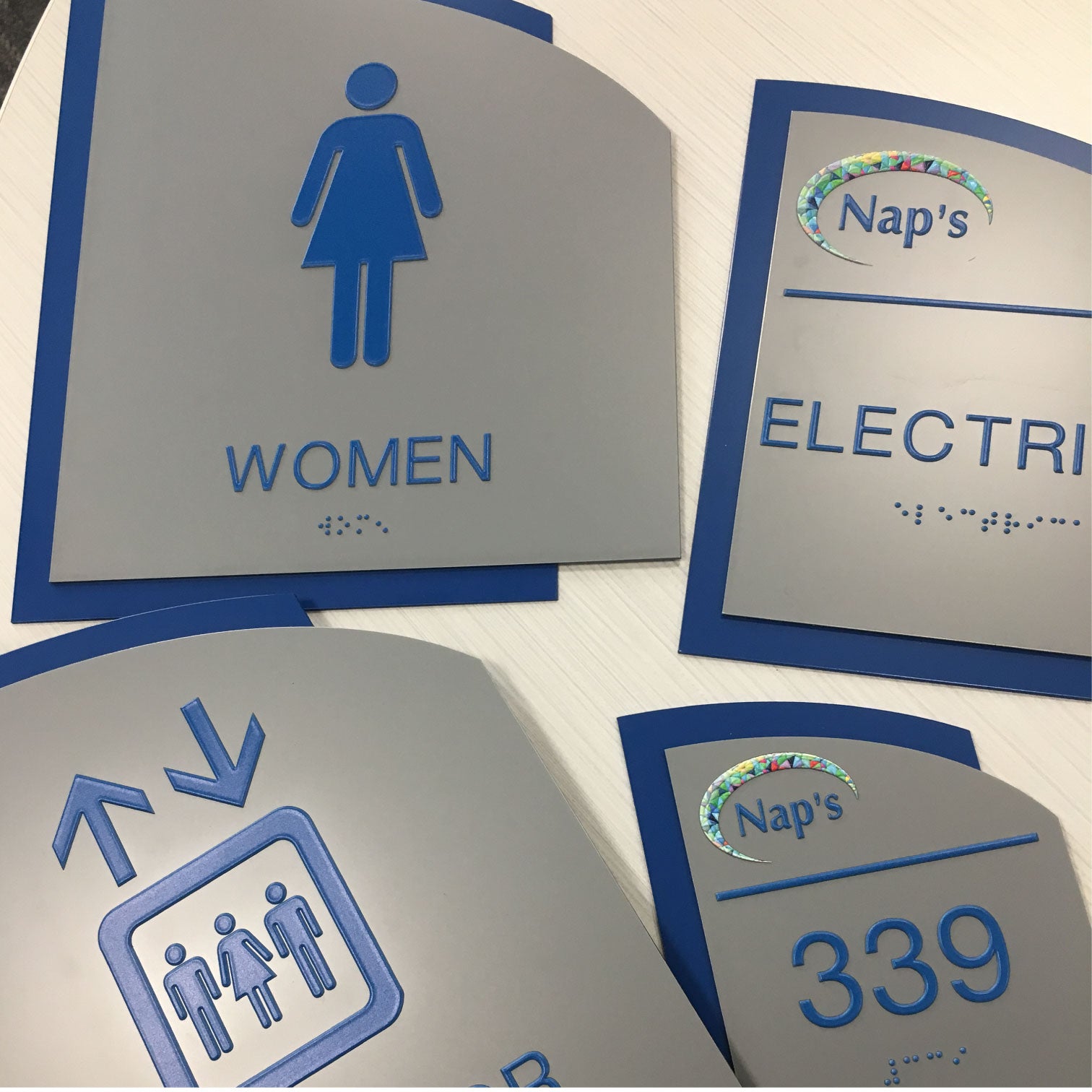Discovering Imaginative Layouts for Reliable ADA Signs
Discovering Imaginative Layouts for Reliable ADA Signs
Blog Article
ADA Signage: Guaranteeing Access and Compliance in Public Spaces
ADA signs plays an essential role in ensuring availability and compliance within public spaces, substantially adding to a comprehensive atmosphere for people with specials needs. By adhering to ADA criteria, signs not just helps with navigating however likewise underscores an organization's dedication to variety and equality. As we check out the nuances of ADA signage, from responsive features to create complexities, it's critical to take into consideration exactly how these aspects integrate to promote the legal rights of all users. What are the usual risks organizations deal with in maintaining compliance, and exactly how can future patterns in signage continue to drive ease of access forward?
Relevance of ADA Signs
In modern-day society, the significance of ADA signage expands beyond mere conformity with legal requireds to embody a commitment to inclusivity and accessibility for all people. These indications are important in producing settings where individuals with disabilities can browse public areas with the very same convenience and self-reliance as those without disabilities. By offering standard and clear info, ADA signs ensures that everyone can access facilities, services, and info without barriers.
The importance of ADA signs depends on its capability to boost the lifestyle for people with disabilities by promoting equivalent access. It removes the obstacles that may otherwise prevent their capacity to take part fully in area life. Additionally, these indications function as noticeable indications of a company's commitment to variety and equal rights, reflecting broader social values that promote the civil liberties and self-respect of all individuals.
Moreover, ADA signage plays an important duty in public safety and security. By assisting people to exits, restrooms, and various other necessary facilities, it guarantees that all people, despite physical ability, can leave safely throughout emergency situations. In summary, ADA signage is not simply a governing demand however an effective tool for fostering a comprehensive and equitable society.
Key Components of Conformity

Placement is crucial; indicators must be mounted in locations that are conveniently noticeable and obtainable. Usually, signs needs to be placed in between 48 and 60 inches from the ground to make sure accessibility for both standing and wheelchair users. Responsive components, such as Braille, are important for individuals with visual disabilities, offering essential information in a non-visual style.
High-contrast colors between the text and history are essential to boost readability for people with reduced vision. The ADA mandates particular comparison proportions to ensure clearness. Additionally, character dimension is a crucial consideration, with minimum elevation requirements determined by the viewing range to guarantee readability from various angles.
Layout Considerations for Accessibility
Creating easily accessible signs requires a meticulous strategy to ensure it fulfills the requirements of all customers, especially those with impairments. This includes considering numerous design components that enhance readability and use. Key variables include the option of font style, shade contrast, and tactile functions. Typefaces need to be sans-serif, with simple and clear letterforms, to assist in simple analysis. The size of the message is just as important, with ADA guidelines suggesting a minimal elevation based on checking out range to guarantee clarity.
Contrasting colors between text and history are vital for exposure, especially for individuals with visual disabilities. Additionally, responsive elements, such as Braille and raised personalities, are crucial for individuals that are blind or have reduced vision.
In addition, the positioning of signage plays a significant duty in accessibility. Indicators need to be set up in locations that are conveniently reachable and unobstructed. Making sure that signage is placed at ideal heights and angles enables all individuals, including those using mobility devices, to communicate with them efficiently.
Usual Errors to Avoid

An additional common mistake is the inaccurate positioning of signage. ADA standards specify specific elevation and location demands to ensure that indications are reachable and quickly visible by all people, including those making use of wheelchairs. Disregarding these standards not just obstructs availability but additionally risks non-compliance with lawful criteria.
Additionally, inadequate comparison between text and history is a constant oversight. Sufficient contrast is essential for readability, especially for people with reduced vision. Designers in some cases pick shades that are visually enticing but do not have the necessary contrast, making the message challenging to determine.
Lastly, some developers fall short to include tactile aspects, such as Braille, which are vital for people that are blind. Omitting these features not just results in non-compliance with ADA laws but additionally restricts gain access to for a sector of the populace that counts on tactile details.
Future Trends in Signage
Improvements in modern technology and increasing awareness of inclusivity are shaping the future trends in signage style. As society ends up being a lot more mindful of diverse requirements, the combination of clever technologies right into signs is obtaining grip. Digital signs, for circumstances, is progressing to include real-time updates and interactive functions, which can be vital in supplying dynamic info in public spaces. These signs often include touch screens or gesture-based controls, allowing users to navigate material tailored to their particular requirements.
One more emerging pattern is the usage of increased truth (AR) to boost individual experience. AR-enabled signs can overlay digital details onto the physical atmosphere, giving visually damaged individuals with auditory or haptic comments. ADA Signs. This modern technology not only improves ease of access but also develops an engaging experience for all individuals
Sustainability is additionally a considerable factor influencing signs fads. Environment-friendly materials and energy-efficient illumination view it now options are being see post focused on to align with worldwide ecological objectives. Developments in products scientific research are leading to the growth of even more durable and weather-resistant indicators.
Final Thought
ADA signs plays a vital role in ensuring availability and compliance within public areas by integrating responsive elements, high-contrast shades, and strategic placement. The adherence to ADA criteria not just facilitates safe navigating for people with disabilities yet also symbolizes an organization's devotion to diversity and inclusivity. By staying clear of typical mistakes and welcoming future fads, public areas can remain to progress these worths, making certain that the civil liberties and self-respect of all people are appreciated and supported.
ADA signage plays a vital role in ensuring access and conformity within public spaces, considerably adding to a comprehensive environment for individuals with handicaps. As we explore the subtleties of ADA signage, from tactile features to create intricacies, it's essential to think about exactly how these aspects integrate to support the rights of all individuals.In modern society, the value of ADA signs extends past simple compliance with lawful requireds to symbolize a dedication to inclusivity and access Learn More Here for all individuals. By offering standard and clear details, ADA signs makes certain that every person can access centers, services, and information without obstacles.
ADA signage plays a vital role in guaranteeing ease of access and compliance within public spaces by integrating tactile elements, high-contrast colors, and critical placement. (ADA Signs)
Report this page